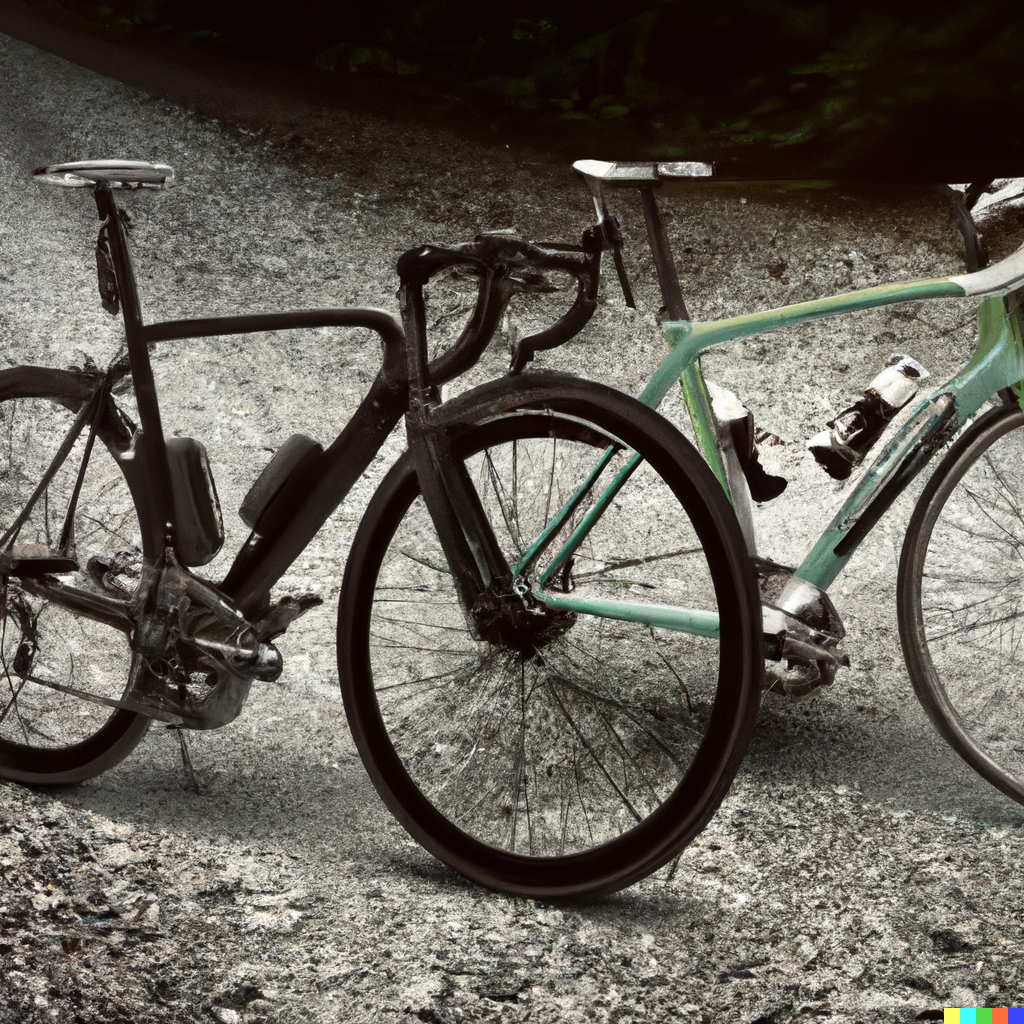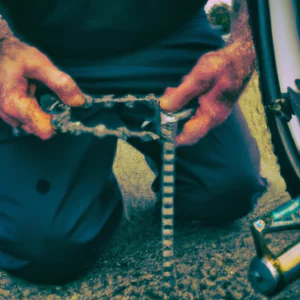An Overview of the main differences between road bikes and gravel bike
Speaking as a passionate cyclist with years of experience in both road and gravel biking, I could immediately point out the key distinctions. Road bikes, often seen zipping through city streets or participating in high-speed countryside tours, are designed especially for smooth, paved surfaces. They are bikes are designed for riding on paved roads and are optimized for speed and efficiency. In contrast, gravel bikes have a distinctively versatile DNA, crafted for those of us who crave adventure on the less-beaten paths of dirt roads, forest tracks, or rocky trails. Gravel bikes are popular for adventure cycling, bikepacking, and exploring mixed-terrain routes.
So, what do these differences mean in terms of design, you ask? Let’s dive into some distinguishing features:
- Tire Width: Road bikes usually sport narrower tires for lower rolling resistance on smooth surfaces. Gravel bikes, on the other hand, are equipped with wider tires for improved grip and comfort on rough terrains.
- Geometry: A road bike’s sharper geometry is meant for a more aggressive riding position, optimizing speed and performance. A gravel bike’s relaxed geometry caters to longer, exploration-based rides, emphasizing comfort and control.
- Gearing: Road bikes typically have a high gearing setup, geared towards speed on flat terrains. The wide-range gearing found on a gravel bike is tailored for varied terrain, from steep climbs to descents.
- Mounts: Gravel bikes are loaded with mounts for carrying gear – think multi-day adventure trips. Your road bike likely lacks these, as it’s built primarily for speed, not cargo.
Now, am I suggesting one type of bike is inherently better than the other? Absolutely not. Rather, the best bike depends on the rider’s intended use, personal preference, and the type of terrain you’ll be riding most frequently. Let’s continue and delve into the specifics of road and gravel bikes that can help you make an informed decision.
Understanding the Basics: What is a Road Bike?
Let’s ride down memory lane, shall we? I remember the first time I experienced the sleek, streamlined elegance of a road bike. It was like a hummingbird, effortlessly agile and designed to excel in its habitat. But what makes a road bike such a creature of the tarmac?
Road bikes, often referred to as ‘racers’, are meticulously crafted for smooth, paved roads. They feature lightweight frames, built for speed and efficiency, with a sleek and aerodynamic design. The thin, high-pressured tires coupled with drop handlebars, often draw your eye. A point to note is the seating position, which might seem a bit aggressive compared to other bikes – it’s more forward, ensuring the cyclist is poised for the maximum power output and minimal wind resistance.
But hey, it’s not all about speed and efficiency. Road bikes pack a punch when it comes to endurance and distance-oriented rides. This is largely attributed to the overall design and gearing setup, with a higher number of gears available to the cyclists. The focused design permits longer journeys with less energy expenditure, making it a favored choice among long-distance cyclists and road racing enthusiasts. Pure speed, endurance, and streamlined style – that’s a road bike for you.
Take it from me, a seasoned cyclist, riding a road bike is a unique experience. The feel of the road, the glide of smooth asphalt under your tires, the speed – it all amalgamates into something rather exhilarating. There’s a certain flow to road biking, a rhythm that when you catch, you ride with an ease and elegance that keeps you always yearning for more.
So, do you now see the allure of a road bike? The enduring romance of the open road, the speed, the ride – it’s not just a bike, it’s a lifestyle.
Exploring the Essentials: What is a Gravel Bike?
When you first lay eyes on a gravel bike, it might seem strikingly similar to a road bike. However, there are a few distinct features that set it apart and give it a unique edge. But what exactly is a gravel bike, and why is it becoming so popular among cycling enthusiasts? Allow me to share my experience and knowledge to help you understand better.
A gravel bike, also known as an adventure bike, is designed to tackle everything from dirt tracks and gravel roads to singletrack trails and tarmac. Gravel bikes are known for their versatility, as they’re suited to long, all-day road rides and tough off-road trails. They’re the Swiss Army knife of the cycling world – a versatile machine that you can take almost anywhere.
So, you may ask, what are the distinguishing characteristics of a gravel bike? Let’s dig a little deeper.
Tire Clearance
The first thing you’ll notice when you look at a gravel bike is the sizeable tire clearance. While road bikes are generally equipped with 25-28mm tires, gravel bikes can handle tires up to 50mm wide. The wider tires provide better traction and comfort on rugged terrain. That’s probably why I find myself reaching for my gravel bike whenever I’m not sure what conditions I might encounter on a ride.
Frame Design
Gravel bikes also boast a unique frame geometry. The frames are designed to provide a more comfortable and stable ride over rough terrain. As a result, they tend to have longer wheelbases and slacker head angles than their road counterparts. This is a feature I came to appreciate after spending countless hours on bumpy bridleways.
Mounting Options
One defining characteristic of gravel bikes is the wide range of mounting options. You can attach multiple water bottles, luggage, mudguards, and more, making them perfect for bicycle touring or bike-packing adventures. Whenever adventure calls, I know my gravel bike is equipped to carry all the essentials I need.
In conclusion, a gravel bike is much more than a road bike with wider tires. It’s a versatile machine designed to handle a wide range of terrains, making it the go-to choice for riders who love a bit of adventure. It’s more than just a bike; it’s a ticket to endless exploration… and who wouldn’t want that?
Frame and Geometry: How They Differ on Road and Gravel Bikes
It’s one thing to talk about the components of road and gravel bikes—tire clearance, frame design, mounting options—but looking closer at the geometry of their frames can really help us understand the nuances that distinguish these two types of bicycles.
Through the lens of personal experience, let me share this: When I first transitioned from my trusty road bike to a gravel bike for some off-road adventures, it was the way the bike “felt” that truly opened my eyes to their differences—an experience I owe to the contrasting frame geometries.
The frame geometry of a road bike is designed with speed and efficiency in mind. A steep head tube angle, combined with a short wheelbase, results in a riding position that’s more leaned forward.
This aggressive position— often likened to being “at the helm of a missile”—allows for quick maneuvering and maximizes power transfer from the rider to the bike. However, it requires a good deal of flexibility and can feel less comfortable on longer rides. But then again, isn’t it the thrill of speed that draws us into road cycling?
On a gravel bike, by contrast, the frame geometry is tweaked for stability and comfort over varied terrain. A slacker head tube angle and longer wheelbase lead to a more upright riding position, reducing pressure on your hands and wrists, aiding in control and balance, especially on uneven ground.
Imagine it like this: If a road bike is akin to a sports car, designed for high speeds and tight corners, then a gravel bike is the trusty SUV—robust, stable, and ready to handle a variety of terrains.
It’s these little subtleties—those stemming from differences in frame geometry—that result in a world of difference when choosing between a road bike and a gravel bike.
In conclusion, while road bikes sport a frame geometry optimized for speed and agility on tarmac, gravel bikes favor a configuration that prizes comfort and stability on unpredictable surfaces.
Factors Impacting Frame Geometry
- Head Tube Angle: A steeper angle found typically on road bikes results in agile, responsive handling. A slacker angle, typically found on gravel bikes, adds stability.
- Wheelbase: Road bikes tend to have a shorter wheelbase for quick maneuvers. Gravel bikes sport a longer wheelbase to allow for greater stability on mixed terrains.
- Rider Position: Road bikes encourage a more aggressive riding position to improve aerodynamics and speed. Gravel bikes offer an upright position for comfort and control on bumpy roads and trails.
Hopefully, the above break-down has provided some illumination for you, as it did for me, on the real contrast between road and gravel bikes in terms of their frame and geometry.
Tire Selection: The Key to Tackling Different Terrains
In the world of cycling, tires are the difference between a smooth ride and a dicey one. When we talk about road bikes and gravel bikes, the tire selection varies considerably in terms of size, pressure, design, and material. Allow me to delve into these differences and enlighten you on how these selections influence your cycling experience.
Tires on road bikes are typically narrow, with widths ranging from 23mm to 28mm. They are designed for speed and efficiency. They operate at high pressures, usually between 80 and 130 psi. This high pressure reduces the rolling resistance and, consequently, the amount of effort required to keep it moving. They usually have a slick design to further reduce resistance and increase speed on tarmac roads.
On the other end, tires for gravel bikes are wider, ranging from 35mm to 50mm. They operate at lower pressures, typically between 30 and 60 psi for The tires often feature a tread pattern designed to maintain grip on loose terrains without sacrificing too much speed.
It’s kind of like the difference between wearing running shoes on a track and hiking boots on a rough, uneven terrain. The former is built for speed and performance on smooth surfaces while the latter is designed for stability and comfort on rugged trails. Your tire selection works under the same principles!
Note: Tire pressure is a subtle yet crucial detail. Too much pressure and you’ll have a bumpy ride with decreased traction. Too little, and you risk a tire puncture. It’s all about finding the sweet spot that suits your style of riding and the terrain you’ll be navigating.
Remember, the tire choice significantly impacts the overall handling and performance of your bike. Therefore, having the correct information can transform your riding experience, whether you’re cruising down smooth city streets or venturing onto gravel-strewn trails. As we move forward, remember that while road bikes are designed for speed, gravel bikes prioritize versatility. What does that mean for you as a cyclist? Let’s find out in the next sections!
Gearing: Finding the Right Setup for Road and Gravel
If you’re like me, a passionate cyclist with a keen eye for detail, then you know all too well that gearing plays a pivotal role in our ride. It directly affects our speed, efficiency, and, most importantly, our overall comfort. Now, let’s delve deeper into the difference in gearing setups between road bikes and gravel bikes.
Road Bike Gearing: Generally, road bikes are equipped with a higher gear ratio. Why, you ask? The simple answer is speed. Road rides mainly demand fast, smooth transitions turning those pedals which high gears effectively facilitate. Usually, road bikes come with a compact or standard double chainring setup. A standard setup might have a 53/39T while a compact setup usually comes with a smaller 50/34T. The smaller the chainring, the easier it is to pedal uphill; the larger the chainring, the faster you can go on flat surfaces.
Gravel Bike Gearing: On the other hand, gravel bikes are kitted out with lower gear ratios. This isn’t a matter of slow riding, not at all. Instead, the rationale here is adaptability — the ability to ride comfortably across varying terrains which, let’s be real, gravel rides are all about. Pitched climbs, rocky routes, and muddy paths? No problem! Lower gear ratios make tackling these possible. Gravel bikes typically come with a double chainring setup although it’s not uncommon to find gravel crushers sporting a single chainring (1X) setup. The advantage of a 1X setup (for instance, 42T with an 11-42T cassette) is its simplicity and reduced weight.
So, which one’s for you? Well, it vividly depends on your riding style and preferred terrains. Get lost in the thrill of speed on smooth tarmac? Road bike gearing is your choice. Prefer a blend of asphalt adventures and dirt-track dreams? Gravel bike gearing offers that coveted versatility.
Synchronized Shifting: The Game Changer
Imagine not having to worry about gear combinations or front derailleur shifts. Sounds like a luxury, doesn’t it? That’s exactly what Synchronized Shift mode lets you enjoy. An exciting innovation in electronic groupsets like Shimano’s Di2, this smart system decides the most seamless and efficient gear changes for you, based on your speed and cadence.
Regardless of your choice, remember: gearing is not about a one-size-fits-all solution, but finding that perfect fit for your unique cycling style and ambitions. Bike like a pro, whichever you go!
“The key to enjoying rides is to have the right gear setup tailored to your specific needs. Don’t compromise on comfort and efficiency for speed. Unlock your true cycling potential.”
Braking Systems: Which is Better for Each Style of Riding?
When it comes to safety on the saddle, a bike’s braking system plays a pivotal role. Whether we’re navigating the paved elegance of a city boulevard on our road bike, or venturing across unchartered gravel paths, the ability to stop reliably and efficiently is a paramount necessity. But is there a preferred braking system for each style? Let’s delve into the intricacies involved.
Road bikes, traditionally, have employed rim brakes. Renowned for their lightweight construction and simple mechanics, rim brakes offer enough stopping power for most road conditions. The mechanism involves applying friction to the wheel rim to slow down the bike. My personal experience with rim brakes has been largely positive for city commuting and general road cycling. However, they can underperform in damp conditions, struggling to shed water from the braking surface, resulting in a slightly prolonged response time.
“In cycling, control is about much more than speed, it’s about making each ride a seamless union between man, machine and the elements. For that, correct braking is quintessential!”
Cue the recent shift to disc brakes in road bikes. Disc brakes, especially the hydraulic versions, provide significantly more braking power and better modulation than rim brakes. They function by pinching a rotor mounted on the wheel hub, hence they are unaffected by wet or dirty conditions. This added control and reliability make them an increasingly popular choice among cyclists. But they do come with an added weight penalty – something to consider if competitive speed is your top priority.
Gravel bikes, on the other hand, near-uniformly feature disc brakes. The reason for this is two-fold: undeniable stopping power and sheer versatility. Gravel riding is multifaceted, meshing elements of road, cross, and off-road biking together. This requires a braking system that can cope with dramatic changes in speed, terrain, and weather conditions – and disc brakes perform exceptionally well on all counts.
Exploring rocky terrains and bracing against windy descents on my gravel bike, I have particularly appreciated the modulation and responsiveness of disc brakes. The assurance that you can stop on a dime, no matter the terrain or the weather, is empowering, to say the least.
But, here’s the rub. Disc brake maintenance is more complex than with rim brakes. The hydraulic systems require traction fluid changes, and the rotors can warp under extreme conditions. So, while the performance gains are clear, the disc systems do demand a degree of technical acuity to keep them in top form. Are you willing to take on this challenge?
My stance on braking is simple: embrace the system that matches your riding style. However, it’s necessary to stay aware of your brakes, understand their limits, respect their maintenance needs, and know that when it’s you versus momentum, they’re your lifesaving allies.
The Bottom Line
In conclusion, when selecting a braking system on a road or gravel bike, several factors come into play – the type of riding you plan on doing, your budget, and your willingness to maintain your bike. Like everything else in life, it’s about finding that judicious balance between performance and practicality for your specific needs.
Riding Experience: How Road and Gravel Bikes Feel on the Road
You might be given the impression that both road and gravel bikes are just variations of a bicycle, but let’s dive a bit deeper and demystify the riding experiences. Hold on, because we’re going into the nitty-gritty of how differently they both feel when we hit the road, or in the case of the gravel bike, off the road.
Road Bikes: Can you remember the exhilaration of riding your first bike? The initial wobbly moments, followed by the rush of the wind as you finally picked up speed? That’s a feeling akin to a ride on a road bike. With its lightweight frame, narrow tires, and forward-leaning riding position, a road bike is designed for speed and efficiency on smooth pavement. You’re positioned to reduce wind resistance, thereby increasing your velocity. The ride can be exhilarating – a pure joy for those fond of high speeds and open tarmac.
Take the open road, add a road bike, throw in your enthusiasm, and what you get is a sublime cocktail of speed, precision, and thrill.
Gravel Bikes: While a ride on a road bike is akin to a swift and smooth waltz, a gravel bike ride is more of an adventurous salsa. With sturdy frames, broader tires, and a more upright riding position, gravel bikes offer a comfortable ride on a variety of terrains. You could be cutting through gravel tracks, dirt roads, or even navigating single-track trails. Yes, it might not be as fast as a road bike on tarmac, but the sense of versatility and adventure it provides is second to none.
With a gravel bike, every ride is an adventure in itself. The world is yours to explore; you’re only limited by your imagination and nerve.
So, are you the speed-loving road racer who thrives on paved surfaces, with the goal of cranking up the mph? Or are you the adventurous soul who loves the chaos of gravel, dirt, and trail, with the aim of uncovering new paths? Understanding this difference in riding experience is crucial as it directly anchors on where you ride and your personal biking style. A road bike gives you efficiency and speed while a gravel bike offers versatility and the thrill of uneven terrains.
Choosing the Right Bike for Your Riding Style: Factors to Consider
Choosing a bike that aligns with your riding style is a strategic endeavor, one that requires an understanding of your own skills, environment, and cycling goals. Let me share some key factors that I consider when I weigh my options between a road bike and a gravel bike.
Your Riding Terrain
First and foremost, where do you plan to ride? If you’re like me, cruising through city lanes, hitting highest speeds on well-paved roads, a road bike can be your best ally. Its design and features make it a suitable option for flat, smooth terrains. In contrast, if you’re an adventurer at heart, trailblazing through rustic backcountry, rocky terrains, or gravel roads, then a gravel bike speaks your language.
Your Comfort Level
Familiarity and comfort should also weigh into your decision. Road bikes have an aggressive geometry which means you bend more while riding, giving you a speed advantage but this position might become uncomfortable over extended periods. Gravel bikes, on the other hand, have a more relaxed geometry. Here’s a question to consider: Do you desire the typical cyclist’s hunched position, or do you find a comfortable upright position more appealing?
Desired Flexibility
Flexibility matters when choosing between a road bike and gravel bike. Sometimes, I just feel like switching up my riding surface or exploring off-beaten tracks. In this case, a gravel bike provides the flexibility to traverse off-road sections and paved roads with ease. While road bikes are faster, they aren’t known for offering the same level of versatility.
Your Purchase Budget
Let’s not sidestep the elephant in the room – budgeting. Road bikes can be a bit on the steep side due to their specialized design and lightweight material. On the other hand, gravel bikes can be comparatively more affordable. So, does your wallet favor a more versatile but modestly priced bicycle, or a high-speed though potentially pricey one?
Your Cycling Goals
Lastly, your cycling goals should dictate your choice. Are you training for a road race where speed is king? Then a road bike can deliver the competitive edge you might be seeking. However, if adventure biking is what stokes your fire, a gravel bike is an excellent companion.
In the end, it’s not about road bikes versus gravel bikes. It’s about what aligns with your personal riding preference, comfort, lifestyle, and objectives. The thrill of biking comes from choosing a bike that matches not just the road in front of you but the adventure that beckons from within.
Benefits of Road Biking: Speed, Efficiency, and Pavement Performance
As a seasoned cyclist, I must admit, there is quite something about the allure of road biking. It’s perhaps the allure of celestial speed. Or maybe, it’s tied to the efficiency of covering ground swiftly. Let me lay it out for you and offer a glimpse into the world of road biking.
First and foremost, speed is the calling card of road biking. Fitted with narrow, smooth tires and lightweight frames, road bikes are designed to fly on pavement surfaces. They command the open road, allowing you to cover significant distances in record time. Nothing beats the adrenaline rush from a high-speed road ride, with the wind whistling past your ears – it’s exhilarating, to say the least!
Experiencing the world at high speed, maneuvering the bends, and relishing that feeling of absolute freedom – isn’t that the very essence of road biking?
Moreover, efficiency is another remarkable benefit of road biking. With their aerodynamic frame design and high-pressure tires, road bikes allow you to cycle farther with less effort. It’s about maximizing each pedal stroke, each pulse of energy expended. Gradients transform from daunting slopes into manageable challenges. So, you see, when it comes to pavement performance, few can argue with the unmatched momentum of a road bike.
| Advantage | Description |
|---|---|
| Speed | Designed for swift movement, allowing for faster rides on smooth surfaces. |
| Efficiency | Aerodynamic frame and high-pressure tires allow for less energy expenditure over greater distances. |
| Pavement Performance | Narrow tires and smooth treads offer excellent grip and control on tarmac, enhancing overall ride quality. |
Ultimately, with road biking, it’s about mastering the tarmac, conquering the long stretches of asphalt that lay ahead. It’s challenging, it’s fast-paced, and above all else, it’s incredibly rewarding. So, what’s stopping you from embracing the thrill of road biking?
Benefits of Gravel Riding: Versatility, Adventure, and Off-Road Thrills
Let’s venture a little deeper into the less beaten path and talk about gravel biking, my friends. Imagine being able to immerse yourself in the tranquility of nature, or conquering an exhilarating rough trail that would make a standard road bike quiver in its clips. Isn’t that a tantalizing prospect? Well, that’s the beauty of gravel bikes: the freedom they offer, and the rugged, off-road experiences they enable.
Versatility is the name of the game here. Gravel bikes are designed to handle a wide range of terrains with respect, grace, and simultaneous dirt-defying defiance. You get the speed and efficiency of a road bike on smooth pavements while also enjoying the capability to transition onto dirt and gravel tracks without missing a beat. You can take it on the road, the gravel, the dirt, the trails – the world is your oyster with a gravel bike.
A sense of adventure is intrinsic to gravel biking. There’s a certain charm in not knowing exactly what lies around the next bend or over the next hill, isn’t there? Well, gravel bikes are designed to handle those surprises, ranging from sudden steep climbs to unexpected rocky paths. They’re also great for bikepacking trips, where you can pack all your gear onto the bike and head off for a weekend (or longer), camping along the way. The sturdy construction and generous mounting options make these bikes tailor-made for adventure seekers.
Oh, the off-road thrills! Imagine the splash of gravel under your tires as your bike glides over undulating terrain, the wind whooshing past your helmet, the stunning changing landscapes that meet your eyes as you traverse different trails. The sense of satisfaction and accomplishment after finishing a challenging ride, the endorphins, the breathtaking vistas – all of these make gravel biking an incredibly rewarding experience.
Thus, if you thrive on exploration and love the thrill of venturing into the unknown mixed with the joy of physical exertion, a gravel bike might very well be your perfect cycling companion.
Now, I cannot stress enough the importance of making sure you are equipped with the right type of bike for your kind of terrain and cycling style. Trust the expertise of years on the saddle, my friends. Whether you choose a road bike or a gravel bike, having the right bicycle can truly enhance the joy and fulfillment derived from your biking journeys.
The road isn’t always perfect out there; why not choose a bike that’s prepared for that? And that, ladies and gentlemen, beautifully captures the spirit of gravel biking!





